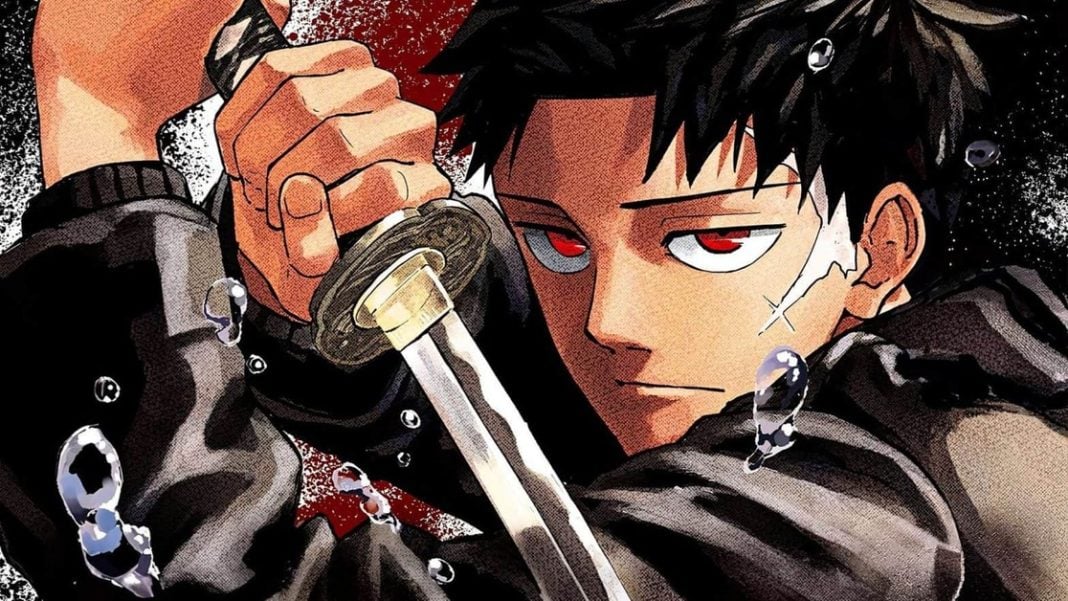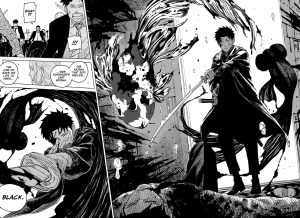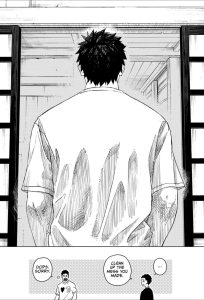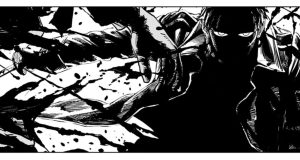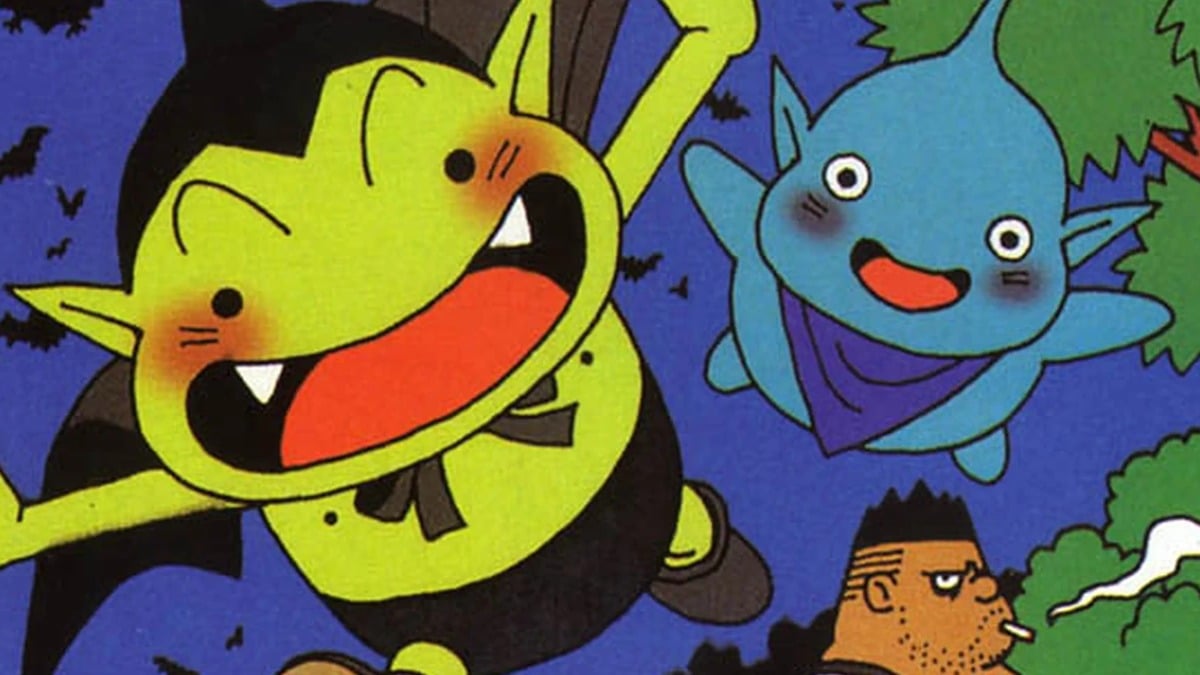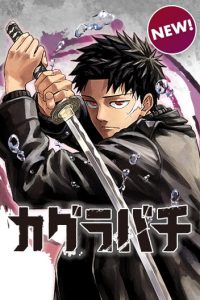
Written and illustrated by Takeru Hokazono
Translated by Camellia Nieh
Lettered by Phil Christie
Published by Shueisha
Simulpub by MANGA Plus, also available on Shonen Jump / VIZ Media
Genre: Shonen, Action, Fantasy
SPOILER ALERT: This review includes some spoilers about events in Kagurabachi Ch. 1.
In the unforgiving world of Shonen Jump, where fierce competition is the norm and only the fittest survive, Kagurabachi by rookie mangaka Takeru Hokazono emerges to defy all conventions.
Picture this: a series that became a viral sensation, giving birth to a mythical “kagurabachillion” in sales and an imaginary Netflix anime adaptation by the highly acclaimed animation studio MAPPA. English Voice Actor Aleks Le inadvertently became a legend, getting accolades for a role he never played for a fictional anime that never was (though he later succumbed to the meme and voiced a fanmade animated clip). All this made-up hullabaloo unfolded well before the ink dried on its very first chapter.
It’s a rollercoaster of irony, where an initial joke has propelled Kagurabachi to the Top 4 MANGA Plus most-read series, amassing over 600 thousand worldwide views. Now, we’re left wondering: Is this newfound fame merely an extension of a joke that snowballed into something colossal, or a testament to its quality? The short answer: the first chapter is just okay.
The story takes place in the 1920s and revolves around Chihiro, an expressionless boy. Chihiro spends his childhood days training under Japan’s most famous swordsmith, his father, Kunishige Rokuhira. Both tirelessly craft special katana blades at the mesmerizing symphony of ‘tang, klang, tatang,’ as steel meets hammer with precision. The workshop is engulfed by their solemn craftsmanship, and the only thing sharper than the blades they forge is the focus etched onto his father’s face.
A deep-rooted respect for the artistry of swordsmithing is lived through Kunishige. But it’s the moral responsibility shouldered by these craftsmen that would shape Chihiro’s unwavering sense of duty. Hokazono underscores the gravity of crafting katana, where each blade can both safeguard lives or end them. Therefore, the burden of entrusting a katana to another becomes a monumental weight to bear. Hokazono brings this immense responsibility to life, dedicating an entire page to illustrate Kunishige’s broad back. A visual testament to the colossal burdens borne by this dignified wordsmith.
So far, Chihiro’s dad sounds like a man worthy of everyone’s admiration, right? Well, here’s the twist. When Kunishige steps out the workshop, he transforms into a carefree, goofy man-child, reminiscent of adult Naruto with his boisterous personality, face expressions, and spiky hair. Honestly, it’s hard not to find Kunishige’s character and his antics amusing.
Flash forward 38 months, and Chihiro is cast as the living embodiment of darkness and vengeance. A sinister face scar, an imposing all-black outfit, and his now-vanished father’s last katana in his hands shrouds Chihiro in an aura of menace. To put the cherry on top of the cake, a splatter of blood adorns his face after he massacres the Korogumi yakuza in a bloodily fashionable style. Hokazono can’t make it any clearer, Chihiro is not your typical charismatic and pure-hearted shonen manga protagonist.
It’s a stark transformation that leaves us wondering about the trauma that ignited Chihiro’s seething thirst for revenge and his deep-seated self-hatred. What unfolded during the timeskip that forever scarred him? The story drops vague hints of a tragic incident in the past, leaving this haunting question floating in the air and opening the door to multiple future storylines and revelations.
Even though the door is open, I am not sure if I want to step through it. You see, the story makes no attempt to appeal to the readers’ emotions or endear us to Chihiro’s character. So, if I don’t have any significant feelings toward the protagonist, why should I care about what happened to him? This is the problem with crafting a one-dimensional character whose only distinctive trait is being edgy. It would be easier to empathize with Chihiro’s father and his dual nature that makes him a far more compelling character.
If the story hasn’t quite reeled you in yet, then the fight sequences most definitely will (as was my case). Chihiro takes over the stage to show off his swordsmanship skills with flair. These battles come alive with dynamic poses, intertwined with alternating camera angles and shots that flow seamlessly. The scene’s composition showcases Chihiro’s unrelenting, brutal prowess as he unleashes a barrage of blood-soaked katana slashes. Hokazono does not hesitate to treat the readers to a visceral display of flying limbs and blood splashes, adding yet another layer of gore and edginess to the manga.
If this was not edgy enough, Hokazono further reinforces Chihiro’s ice-cold resolve through close-up shots of his emblematic ominous gaze. My favorite panel from this chapter shows exactly this: his death stare. Framed within a whirlwind of dismembered limbs and a torrent of blood, shadows cloak Chihiro’s face and body, with only his eyes piercing through to meet the reader’s eyes. Looking at that panel feels like death is on the prowl to get me. Literal chills.
Hokazono definitely knows his way around the pen. The use of shadowing techniques impeccably sets the tense and dramatic mood. Gray tones are used against a plain white background, creating contrast and heightening visual impact. The clean aesthetic leaves make the action stand out vividly, as the hatching techniques breathe life into the characters, denoting the speed and intensity of each strike with an authentic sense of realism. And the cross-hatching adds a layer of texture that elevates the overall visual appeal of the work.
In the final stretch of the chapter, Chihiro releases the sorcery power of his katana, summoning two goldfish. Although an interesting choice, the goldfish are more ornamental than integrated into every movement, unlike the breathing techniques in Demon Slayer, where they play a key visual role. Here, it simply represents a straightforward power-up with no further explanation given in the chapter. Shonen Jump readers are no strangers to the trope of katana and sorcery, so Hokazono will have to delve deeper into the sorcery power system to draw his readers into the world of Kagurabachi.
Circling back to the burning question posed in the title: Is Kagurabachi a memetic marvel or a true manga masterpiece? Well, it turns out, it’s neither. Kagurabachi isn’t out here reinventing the wheel or redefining the shonen genre. It’s your run-of-the-mill shonen manga with flashy fights, but lacking that extra zing to truly grasp its readers. Sure, Hokazono does throw in some peculiar choices. Like giving us an expressionless, edgy protagonist in a magazine bursting with passionate and virtuous heroes. But, personally, I feel this decision might be working against him.
But hey, let’s not forget this is just the first chapter. More like a prologue, really. We’ve barely scratched the surface of the plot. Even so, Hokazono has managed to wow us with his art craft and ability to make compelling fight scenes. Kagurabachi will have plenty of opportunities to work its magic and become the life-changing masterpiece the Western world has prematurely made it out to be. I am a sucker for sword-fighting manga, so I will have my fingers crossed and hope for exciting twists and turns in the chapters to come! In the meantime, I’ll keep enjoying the memes.
The first chapter of Kagurabachi is currently available to read in English on MANGA Plus. or on VIZ Media’s Shonen Jump website and apps.


